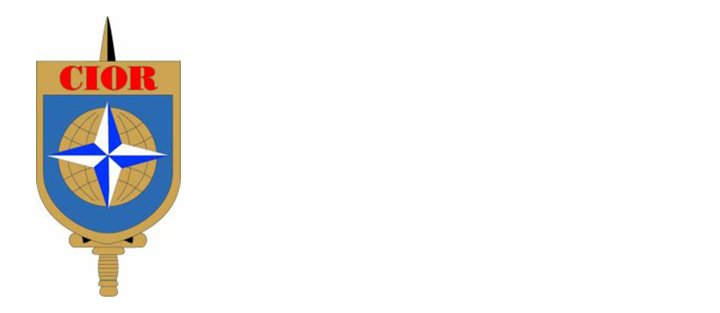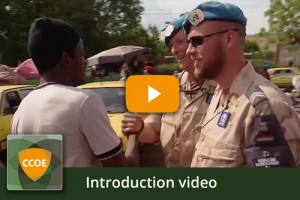“Readiness and the Reserves in CIMIC” Speech DIR CCOE (COL Roel Been, NLD)
CIOR Symposium, Sofia, Bulgaria,
August 6th, 2015
Dear CIOR members, delegates, ladies and gentlemen,
When I was asked to present to this special audience the opening “Readiness” address, I was thrilled beyond recognition. And I still am. Both thrilled and excited, as I felt like a little boy with a jar full of cookies. Or to use another, more fitting analogy, as excited as a Military recruiter appealing to a large number of potential and highly qualified recruits.
Yes, you heard me right: because of your Military and civilian careers I am here to recruit you; to recruit you into the highly challenging and game-changing functional area of Civil-Military Cooperation and Civil-Military Interaction with civilian stakeholders. Due to your civilian expertise as reservists, you are already qualified as subject matter experts in CMI. You are able to interact with local populations, administrators, contractors and support organizations, unlike most full-time soldiers. With your civilian expertise, you are the ones who will be able to facilitate the transition from military operations to peace; and from post-conflict stabilization to the re-establishment of civil authority.
And I am here today, as the Director of the NATO CIMIC Centre of Excellence, to recruit you for this task. My name is Colonel Roel Been. Happy to meet you!
The CCOE is the NATO accredited Centre tasked to create an overruling and unifying understanding of Civil-Military-Interaction in missions. Hundreds of allied soldiers, reservists and civilian experts pass through our multi-level courses every year. And training and exercises are all about this never ending process called “Readiness”.
Before, however, registering you for specialized CIMIC training with us at the CCOE, I need to span the bridge from the recent application of CMI during the last two decades, to our current and future challenges. And the specific degree of “Readiness” which is required of us at this time.
My thoughts will also focus strongly on the civilian society impact and objectives of “Readiness in Civil-Military interaction, given the rapidly changing social, cultural, security and regional environments we are operating in.
Indeed, these are bright and threatening times all at once. And at the CIMIC Center of Excellence, we are dealing with these current challenges, as well as with the preparation for new ones. At the same time, we are constantly seeking to support the enabling of better times in regions struck by violent strive, tribal unrest and armed aggression. In March this year, General Middendorp, the Commander of the Netherlands Forces called for shock resistant partnerships because there is no exclusive Military answer! This is a serious wake up call for us all. And a call to ready ourselves!
Please allow me to highlight some of the social and economic processes affecting the future of CMI and the outlook of the CCOE with it:
We are now apparently in a phase of transformation in several global regions. This challenges us with increased geopolitical distress also in Eastern Europe, North and Central Africa and across the Middle East region – our Southern flank. There is a band of fire around the European borders. Our borders. Just a few hundred kilometers away.
In this highly inter-connected world, sudden tidal waves from ecologic, biologic or economic disturbances quickly reach many, even distant societies. They are resulting in massive impact on people’s lives and the individual reaction to these shocks. The downing of MH17 above the Eastern Ukraine with the loss of 300 innocent people, and the aftermath of collecting all the bodies, did wake up the Dutch people and politicians. There is war and conflict all around us!
We are faced with diverse hybrid threats. Those might also materialize as asymmetrical insurgencies. In cyber warfare, we have just seen the hacking of a television station in France, data-extraction from accounts in the German parliament and the digital intrusion into the Sony Corporation.
Propaganda, indoctrination, economic collapse, or even a toxic mixture of these, can be as effective as weapons in de-stabilizing societies; all demanding multi-dimensional answers and responses.
And to be honest: freedom is not for free. It needs a lot of money, professional armies and an iron will to cooperate with everyone in our forces and outside!
Driven by NATO’s Wales Summit less than a year ago Allied leaders approved the “Readiness Action Plan”. The implementation of Assurance Measures, through rotational deployment of forces with our Eastern Allies, is already in full swing. As well as NATO’s new spearhead force: the Very High Readiness Task Force, VJTF.
At the CCOE, as NATOs CIMIC training and policy center, our focus is consequently on the activation of the related approach applicable to CMI. Following the long emphasis on fighting insurgency in Afghanistan, the focus is now on the facilitation of capability building for CMI in our newly identified areas of regional concern.
For example, within the upcoming Trident Juncture 2015 exercise, our CCOE will expose all Allied participants to key scenarios in crisis management and engagement with international organizations. This exercise, which will involve 36,000 soldiers this November, taking place in Italy, Portugal and Spain. This will be the largest such exercise since 2002 and constitutes NATO’s response to Vladimir Putin. “NATO is ready to defend the people, to defend the territory, and to defend the values of the Alliance”. Deterrence is back in town!
And this is just the point, where in my understanding the future task of NATO’s CIMIC and the roles of the reserves commence to overlap when it comes to Relevance, Integration and Adaptation.
CMI, as conducted by CIMIC personnel is by and large a non-kinetic activity. As such, and despite the success of Civil-Military interaction in Afghanistan and the Balkans, there is on ongoing argument with the kinetic-side as to the relevance of CIMIC in current and future scenarios.
An identified, armed opponent might be neutralized in a kinetic way. The hearts and minds of a population, however, the very breeding and hiding ground of this opponent, can only be won through interaction and positive engagement. CIMIC operations do save lives, those of our soldiers, as well as of the affected civilian population. And proper CMI paves the way for the re-establishment of civilian societies and the transfer to civilian authority.
In order to succeed within the mission landscape, CIMIC must still become a much more integrated activity of all of our forces to enable mission success. And who would be more suited to drive this integration process than the people who already balance a civilian perspective with the Military one?
And here it is again the members of the Reserves, who already possess the skills, network and civilian standing to drive the further civilian side integration of CIMIC activities. This is especially true regarding the large number of international and especially non-governmental organizations, which are often hesitant to engage with the Armed Forces.
The implementation of the “Readiness Action Plan” was quickly seconded by demands for “more resources”. In times of financial restraints, and other real costly support programs, Allied Powers are hard pressed to adapt their Military objectives to those financial constraints. This provides for a unique opportunity for CIMIC to demonstrate that civilian-centric problems do rather demand civilian-oriented solutions, than kinetic ones.
This adaptation, however, requires the active engagement of current and future CIMIC soldiers and reservists. Volunteer your expertise and apply it, specifically to mainstream CMI throughout all Allied channels! Especially, as properly conducted, CMI is fiscally al lot more affordable than any kinetic activity!
“Readiness” in this context should not be understood as a status quo, but rather as an ongoing process, a call for action for me and for all of you to ready ourselves for these challenges.
At the CCOE, we certainly do not have the one master plan to solve all these issues at once. Yet we do consider us as tag team partners with our civilian counterparts to find common answers in a highly complex system of: stakeholders, needs, desires, threats and operational options. The CCOE is training the experts from the civilian and the Military side alike to interact effectively in missions. Here, we clearly follow the motto: “Meet them, before you need them.”
We also utilize all other means of modern information communication technology and social media to spread the message and to engage civilian stakeholders. Wherever they are
As a first step of engagement, I invite all of you interact with us on the internet, may this be on Facebook, LinkedIn, or Twitter. Additionally, our “Network Area”, embedded in our homepage, enables you as experts to contribute to the crafting of CMI policies, the exchange of ideas and creation of new concepts.
The CCOE has now embarked on a new chapter in its still young, 9 year history. We are in the process to re-position the CCOE as the key interface between the civilian and Military communities in Civil Military interaction: at home as well as in mission.
With our recent move into The Hague, the International City of Peace and Justice, we are much closer to align with and cooperate with around 200 civilian organizations located nearby. From there, we will reach out beyond to partner with further institutions and academia across the international CMI landscape.
Adapting to a changed environment also led to a repositioning towards the civilian landscape with a new logo, claim and corporate design for our communications appearance.
“Uniting overlaps” – represents our claim that only by finding common ground among all stakeholders, we will be able to gain unity of purpose in the field of CMI. This, dear friends, might end wars earlier, this might bring peace and rule of law sooner and this will make people more self-sufficient and happy.
With the CCOE Vision 2020, we staked out our mission ahead. We are capitalizing on our message as: “the preferred network campus, to connect people, share collective knowledge and to gain unity of purpose in the field of Civil-Military Interaction”.
Please allow me a few thoughts to elaborate on these key tenants:
The CCOE provides a unique networking platform, the open stage for all stakeholders and actors in CMI, to openly communicate, to forge bonds, to exchange and challenge ideas and to define our common purpose. It is here where personal and institutional networks are being created to enable effective mission work.
Connection defines our enhanced efforts to pro-actively engage with a broad range of civilian CMI stakeholders.
We share our knowledge with external partners and we will create the means and the opportunities for outside stakeholders to share their enormous expertise within our community.
The CCOE will contribute to the proposals and ideas received from the CIMIC community and invites outside stakeholders to likewise contribute to common projects. Ladies and gentlemen, your contributions are more than welcome!
This understanding manifests itself in the key products offered by the CCOE:
The NATO Military Committee has endorsed the revised policy on CIMIC and CMI, which is key to the universal application of CIMIC doctrine and processes throughout NATO. The translation into NATO Doctrine is now ongoing and we’re leading this process as custodian.
This fall we will launch the first ever ”Master of CMI”, conducted in close cooperation with the Helmut-Schmidt University (HSU) of the German Bundeswehr in Hamburg. We’re entering the academic world in many nations!
Our course landscape is constantly upgraded and implements cross-cultural competence into all our tactical level courses. Like: gender, children and armed conflicts and anti-corruption. Most courses include a significant e-learning platform, allowing students to conduct some or all parts of their study from home.
Our trainers also support external courses and exercises, like the CIOR CIMEX in the last days. During the previous 4 years, the CCOE has provided education and training to 1,800 civilian and military students from 52 countries. And all our courses are open to active Military and civilians. And for you: the Reserves!
By using advanced information communication technology, Lessons Learned and Best Practices are being made available for the overall CMI community.
The CCOE’s Mission App will be the first such product of its kind. It will feature surfaces for all mission critical information. It has been designed as an open source tool with a clear intent to be used by civilian and military actors alike. The Mission App will make the same tactical information available for everyone.
As a world premiere here today in Sofia, the following video will give you an idea as to how this civil-Military Cooperation works out in the real world.
Well, where does this all leaves you in the reserves?
Thousands of reservists have already served in the major deployment areas during these last two decades; serving as regular soldiers along with their full-time brothers in arms. You added expertise and know-how to operations and scenarios, the regular forces did not have to offer at the time and location needed.
This number is to be seen in addition to the tens of thousands of reservist who contribute their time and expertise at home, staffing positions and filling roles which would otherwise lie vacant. Or completing tasks and projects which would otherwise lie waste.
In the last decades, more and more of our Forces have changed their personnel policy from a draft system to volunteer structures, leading to a more professional, albeit smaller number of available soldiers.
As much as Assurance Measures will require a stronger commitment of regular forces, the related Adaptation Measures will thus call for a stronger commitment and readiness of the reserves. And as more regions with larger populations are affected, it will take many more reservists to provide the civilian-centric answers and management skills to turn stability operations forward into civil governance.
Dear ladies and gentlemen. To summarize:
- There is a band of fire around European territory
- And there is no exclusive military solution
- Freedom is not for free, it needs money, professional armies and an iron will to cooperate between Military and civilian entities.
- NATO is ready to defend and Trident Juncture 2015 will be the showcase!
- CMI is an activity especially suited for the skills of the reserves. If properly applied wars end sooner, hope returns to people and at the end it will save lives of soldiers and civilians. And it enables peace!
If you are ready for this?! Then join us for training in The Hague and do become a certified CIMIC officer! You can also volunteer as a subject matter expert in your field of expertise and contribute to ongoing programs and initiatives, or study for your Master in Civil-Military-Interaction.
I want you in The Hague!
Thank you for your kind attention.


